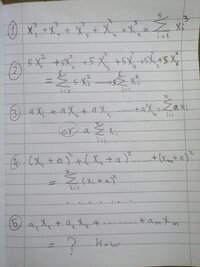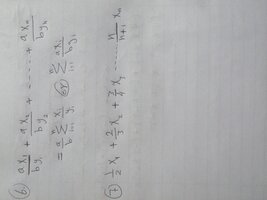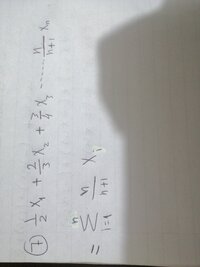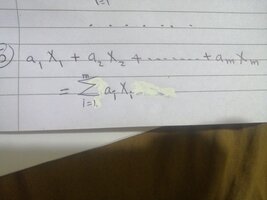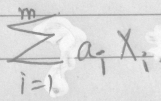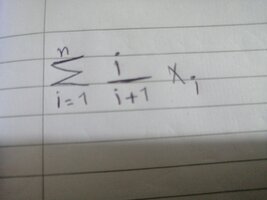You are using an out of date browser. It may not display this or other websites correctly.
You should upgrade or use an alternative browser.
You should upgrade or use an alternative browser.
SUM #2: a * sum{i=1, n} X_i (I know the 1st 4 but how to write last 4)
- Thread starter Barbra
- Start date
Dr.Peterson
Elite Member
- Joined
- Nov 12, 2017
- Messages
- 16,863
Please show your attempts at all of them, including the four you think you know. We need to see how you see them differently.How to write these in SUM form
I know the first four but how to write the last four
I will point out that where you wrote [math]a\sum_{i=1}^n x_i[/math] I would write [math]\sum_{i=1}^n ax_i[/math] so that it says exactly what the given sum does, with no modifications.
Please show your attempts at all of them, including the four you think you know. We need to see how you see them differently.
I will point out that where you wrote [math]a\sum_{i=1}^n x_i[/math] I would write [math]\sum_{i=1}^n ax_i[/math] so that it says exactly what the given sum does, with no modifications.
Actually i can't try with last three ones
About your way it's also right yeah it's same
Attachments
Please make your images right side up and big enough to read
I tried with them all and i think i did well, but i left two, i can't know their answers
Attachments
Dr.Peterson
Elite Member
- Joined
- Nov 12, 2017
- Messages
- 16,863
These are almost the same as the one I showed:Actually i can't try with last three ones
About your way it's also right yeah it's same
In the first, the only new thing is that the coefficients [imath]a[/imath] have been subscripted, [imath]a_i[/imath]. Just insert that in what I wrote.
In the second, the coefficients are back to being constants, but there is a fraction. What will the ith term be?
As for
again, what is the ith term? You just replace n with i. Put that after the sigma, and you have it.
I get the impression you think something about this is far more complicated than it actually is! Please do try; probably if you try at all, you will be right, or nearly so.
Continuing ...
is correct.
These are almost the same as the one I showed:
In the first, the only new thing is that the coefficients [imath]a[/imath] have been subscripted, [imath]a_i[/imath]. Just insert that in what I wrote.
In the second, the coefficients are back to being constants, but there is a fraction. What will the ith term be?
As for
again, what is the ith term? You just replace n with i. Put that after the sigma, and you have it.
I get the impression you think something about this is far more complicated than it actually is! Please do try; probably if you try at all, you will be right, or nearly so.
Continuing ...
is correct.
Can you see it please
Dr.Peterson
Elite Member
- Joined
- Nov 12, 2017
- Messages
- 16,863
Not quite. You've used the last (nth) coefficient for every term. What is the coefficient of the ith term?
That's correct. You can check by replacing i with 1, 2, 3, ... and confirming that you get the terms they showed.
And this is something you should always do! In fact, you can think of the work you are doing as asking yourself, "What can I write in the summation that will result in each of these terms?"
That's correct. You can check by replacing i with 1, 2, 3, ... and confirming that you get the terms they showed.
And this is something you should always do! In fact, you can think of the work you are doing as asking yourself, "What can I write in the summation that will result in each of these terms?"
Not quite. You've used the last (nth) coefficient for every term. What is the coefficient of the ith term?
That's correct. You can check by replacing i with 1, 2, 3, ... and confirming that you get the terms they showed.
And this is something you should always do! In fact, you can think of the work you are doing as asking yourself, "What can I write in the summation that will result in each of these terms?"
Oh yeah i got it now thank you for helping me
So it's correct now?
Attachments
Dr.Peterson
Elite Member
- Joined
- Nov 12, 2017
- Messages
- 16,863
Yes. When [imath]i=1[/imath], the term is [imath]\frac{1}{2}x_1[/imath]; when [imath]i=2[/imath], the term is [imath]\frac{2}{3}x_2[/imath]; and so on.Oh yeah i got it now thank you for helping me
So it's correct now?
This example was a little different from the others, in that they show an expression only for the last coefficient, which represents all the others; but it uses the index for that last term, which you have to change for others.
Steven G
Elite Member
- Joined
- Dec 30, 2014
- Messages
- 14,600
View attachment 34831
Let's look at the 1st one.
1) In each term what is the same? They all have ax.
2) What is changing in each term? The subscripts of a and x are changing. They are going from 1 to m.
Call what is changing k (or any symbol of your choice)
Then you have \(\displaystyle \sum _{k=1}^m a_k x_k\)
You try the 2nd one.
Let's look at the 1st one.
1) In each term what is the same? They all have ax.
2) What is changing in each term? The subscripts of a and x are changing. They are going from 1 to m.
Call what is changing k (or any symbol of your choice)
Then you have \(\displaystyle \sum _{k=1}^m a_k x_k\)
You try the 2nd one.



